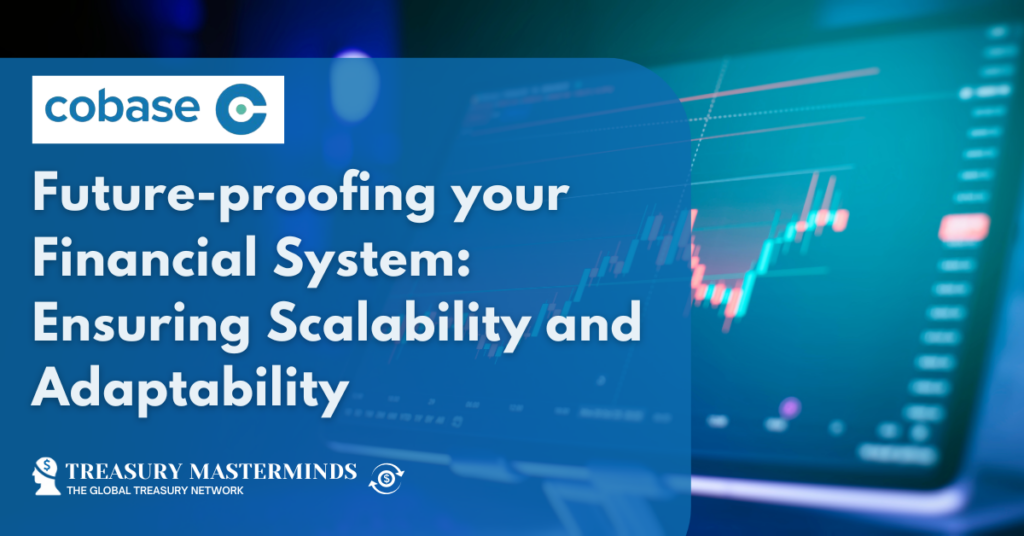
Future-proofing your Financial System: Ensuring Scalability and Adaptability
This article is written by Cobase The ability to adapt and grow is essential for any business. As your company evolves, your financial system must be capable of scaling with you—whether that means handling increased transaction volumes, integrating with new technologies, or expanding into new markets. However, not all systems are built with the future in mind. Let’s explore how to future-proof your financial operations, ensuring that your system remains scalable, adaptable, and ready to meet whatever challenges lie ahead. The importance of scalability in financial systems Scalability is more than just a buzzword; it’s a critical feature that determines whether your financial system can grow alongside your business. As your company expands—whether through organic growth, acquisitions, or entering new markets—your financial operations will naturally become more complex. A scalable system should be able to handle this increased complexity without a hitch, enabling you to manage more transactions, integrate additional banks and accounts, and support a growing user base. Without scalability, your financial system might become a bottleneck, slowing down operations and limiting your ability to capitalize on new opportunities. This can lead to frustration, inefficiency, and, in the worst-case scenario, the need to invest in an entirely new system far sooner than expected. The risks of an inflexible system An inflexible financial system can pose significant risks to your business. If your system isn’t designed to scale, you might find yourself struggling with slower processing times, increased errors, or even system failures as your transaction volume grows. Integrating new banks or accounts might become a time-consuming and costly process, hindering your ability to respond to market opportunities quickly. Moreover, an inflexible system can limit your ability to innovate. As new financial technologies emerge, you may want to integrate advanced features like real-time payments, enhanced data analytics, or AI-driven forecasting. However, if your system isn’t built to accommodate these advancements, you could be left behind, unable to leverage the latest tools that could give your business a competitive edge. How Cobase ensures scalability and adaptability At Cobase, we understand that your financial system needs to do more than just meet today’s requirements—it needs to be ready for tomorrow’s challenges as well. Our platform is designed with scalability and adaptability at its core, ensuring that as your business grows and evolves, your financial operations can keep pace. Effortless scaling with your business Cobase’s platform is built to scale effortlessly with your business. Whether you’re adding new users, increasing transaction volumes, or integrating additional banks and accounts, our system handles it all without breaking a sweat. We’ve designed Cobase to be flexible, so you can expand your financial operations as needed, without worrying about hitting technical limitations or incurring prohibitive costs. As your business grows, Cobase grows with you, ensuring that your financial system remains a powerful asset, not a constraint. Seamless integration of new banks and accounts Expanding into new markets or acquiring new businesses often means adding new banks and accounts to your financial system. With Cobase, this process is smooth and efficient. Our platform is designed to integrate seamlessly with a wide range of banks and financial institutions worldwide. Whether you’re adding a single new account or connecting to a new banking partner in another country, Cobase ensures that your financial operations continue without disruption. Our extensive library of pre-existing connectors and templates means that we can quickly adapt to new requirements, making the process of scaling up as frictionless as possible. Adapting to new technologies and regulations The financial landscape is constantly changing, with new technologies and regulations emerging all the time. Cobase is built to adapt to these changes, ensuring that your system stays up-to-date and compliant with the latest standards. Whether it’s integrating with new payment technologies, adopting AI-driven analytics, or complying with new regulatory requirements, Cobase ensures that your system is always ready to meet the challenges of tomorrow. Our proactive approach to updates and maintenance means that your system stays ahead of the curve, allowing you to leverage new opportunities as they arise. Ensuring a future-proof investment Investing in a financial system is a long-term commitment, and you want to ensure that your investment will stand the test of time. Cobase is designed to be a future-proof solution, capable of evolving alongside your business. Our commitment to continuous improvement, coupled with our focus on scalability and adaptability, means that your financial system will remain relevant and effective, no matter how the business landscape changes. With Cobase, you’re not just investing in a financial system—you’re investing in a platform that will grow and adapt with you, ensuring that your financial operations remain efficient, secure, and competitive for years to come. The Cobase difference: scalability without limits At Cobase, we believe in creating systems that empower businesses to reach their full potential. Our platform is designed to remove the barriers to growth, offering unmatched scalability and adaptability. We take the complexity out of scaling your financial operations, allowing you to focus on what you do best—growing your business. When you choose Cobase, you’re choosing a partner committed to your long-term success. Our scalable, adaptable platform ensures that your financial operations can keep pace with your ambitions, no matter how big they grow. No limits, just possibilities. E-Book Money moves: 6 secrets of financial leaders The financial world is changing fast. To stay ahead, you need more than just the numbers—you need creativity, adaptability, and a big-picture mindset. Download our e-book, “Money Moves: 6 Secrets of Financial Leaders,” to discover the strategies that top CFOs, Treasurers, and Finance Directors use to lead in a rapidly evolving landscape. What you’ll learn: This e-book is for forward-thinking financial professionals ready to drive change and lead the way. Also Read Join our Treasury Community Treasury Masterminds is a community of professionals working in treasury management or those interested in learning more about various topics related to treasury management, including cash management, foreign exchange management, and payments. To register and connect with Treasury professionals, click [HERE] or fill out the form below to get…

Why Excel Fails at Cash Flow Forecasting
This article is written by Nomentia Cash flow forecasting serves a foundational function in the financial planning of any business. It provides answers to questions like: “Do we have enough cash to meet our immediate and short-term obligations?” “How much cash do we need to set aside for upcoming tax payments?” and “What are our projected cash inflows and outflows for the next week, month, or quarter?” What you need to ask yourself, though, is if Excel is still enough to manage your company’s cash flow forecasting, especially in the volatile, uncertain global environment. While it remains a familiar tool for many, its limitations are increasingly evident when handling complex financial operations. How do manual processes and static spreadsheets impact the accuracy of global cash flow forecasts? Why do errors in Excel-based forecasts lead to costly business decisions? If your business is growing, expanding internationally, or managing multiple subsidiaries, relying on Excel could be holding you back. Let’s take a look at why transitioning to dedicated cash flow forecasting software is more than just an upgrade: Meet Hubert Rappold Karl-Henrik Sundberg is a Senior Product Manager for Cash Forecasting at Nomentia, with nearly a decade of experience at the company. He brings valuable expertise from his prior roles as Director of Group Cash Management and Back Office in a Corporate Treasury, as well as in cash management software. What is cash flow: An overview Cash flow is the movement of money into and out of a business; it’s crucial for tracking the liquidity and financial health of your business. Cash flow has two core components: inflows—revenue from sales, loans, or investments—and outflows—expenses like payroll, inventory, and debt payments. Why cash flow matters? Managing cash flow is critical for sustaining your business operations. Strong cash flow allows companies to meet their obligations and seize growth opportunities. Efficient cash flow control boosts operational efficiency by optimizing resource allocation, reducing costs, and maintaining smooth daily functions. Making decisions about cash, investments, expansions, and risk management requires planning and strategizing, which calls for accurate cash flow forecasting. The importance of cash flow forecasting Cash flow forecasting predicts a business’s future cash inflows and outflows over a set period. Its purpose? To ensure liquidity, plan investments, and avoid financial surprises. Key elements of cash flow forecast include projected revenues, expenses, payment schedules, and seasonal fluctuations. Why is accurate cash flow forecasting business-critical? Accurate forecasting isn’t just a finance exercise—it’s a survival tool. Imagine a retailer projecting a holiday sales spike. Or a manufacturer losing a key client. Without precise forecasting, businesses might understock inventory, miss revenue, and drain their cash reserves. In the first case scenario, they might even go under. A solid cash forecast prevents cash shortages and ensures the funds are available when needed. Cash forecasting benefits: Creating a cash flow forecast Creating a cash flow forecast is simple, at least on paper. In reality, cash flow forecasting tends to be a little more cumbersome than that, though. Depending on what tools you use to create your forecasts, you might spend more time collecting your cash flow data than actually analyzing and supporting your business. As Hubert Rappold puts it: “While Excel offers flexibility and ease of use for small-scale cash flow forecasting, it quickly becomes unwieldy as data volume grows, leading to slower processing and more frequent errors.” How does using Excel affect cash flow forecasting? “The real challenge with Excel for cash flow forecasting arises when changes are needed—updating formulas, distributing new versions, and managing consolidation issues can turn a simple adjustment into a logistical nightmare.”- Hubert Rappold, Senior Treasury Expert, Nomentia Quoting Hubert: “Excel’s lack of automation and difficulty in handling integrated data becomes a major bottleneck as companies scale, which is where purpose-built cash forecasting software can deliver substantial value in terms of accuracy and time savings.” As Hubert puts it: “As forecasting periods extend and data complexity increases, Excel often breaks down, turning what was once an efficient tool into a source of frustration and risk.” “As companies expand beyond just a few entities, the inefficiencies of Excel become glaringly obvious—especially when integrating data from multiple systems like ERPs, banks, and controlling systems.” – Hubert Rappold, Senior Treasury Expert, Nomentia How Excel falls short for cash flow forecasting? “The need for accuracy in cash flow forecasting becomes clear when businesses face financial difficulties or even restructuring. Relying on Excel without automation or integration can lead to dangerous miscalculations.” – Hubert Rappold, Senior Treasury Expert, Nomentia Feature Excel Cash flow forecasting software Cash flow data consolidation Complex, manual consolidation from multiple sources leads to inconsistencies and delays. Automatically integrates data from multiple entities, systems, and banks, providing a unified, accurate view of cash flow. Currency differentiation Difficult to manage and update multiple currencies manually, increasing error risk. Seamlessly handles multiple currencies with automatic exchange rate updates and conversion accuracy. Intercompany reconciliation Time-consuming and error-prone due to manual processes. Automates intercompany reconciliation, reducing errors and saving time. Cash flow data entry High risk of data entry errors, missed transactions, and formula mistakes. Minimizes manual input with automated data imports, significantly reducing human error. Real-time data integration No direct integration with ERP systems, banks, or other financial platforms. Real-time data integration ensures up-to-date forecasts and faster decision-making. Forecast detail complexity management Difficult to handle detailed, multi-layered forecasting scenarios, especially for large entities. Designed to manage complex, multi-scenario forecasts with ease, improving accuracy and clarity. Scenario analysis Tedious to create, update, and compare multiple scenarios; prone to formula errors. Easily generates and compares various scenarios with dynamic updates for better strategic planning. Automation and alerts No built-in alerts or plausibility checks; discrepancies often go unnoticed. Automated alerts and anomaly detection flag inconsistencies for faster resolution. Process efficiency Significant time spent on consolidating data and manual updates, leaving less time for analysis. Streamlines data processing, freeing up time for strategic analysis and value-added activities. The advantages of a dedicated cash flow forecasting solution In comparison to Excel-based forecasting, cash flow forecasting software offers superior accuracy, efficiency,…
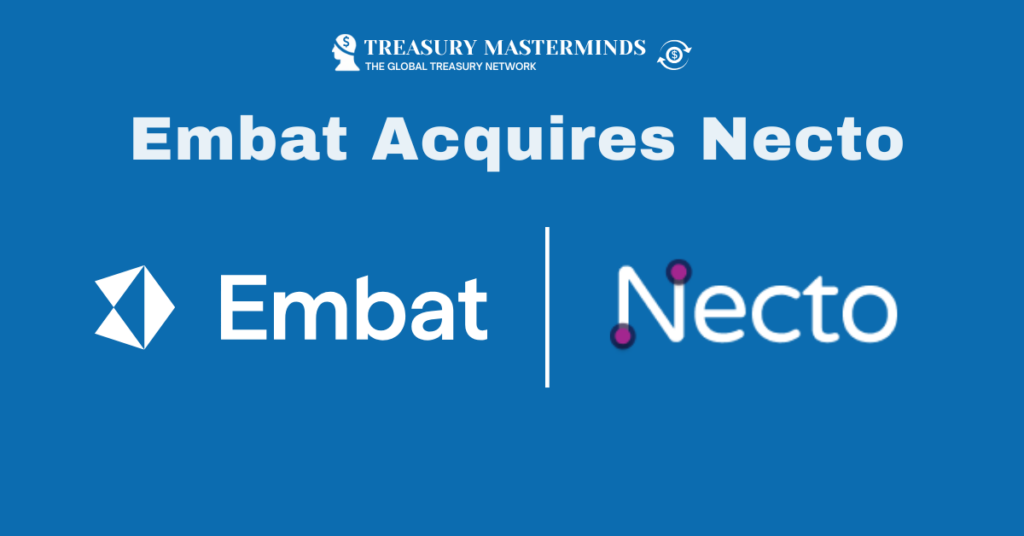
Embat Acquires Necto: Strengthening Its Leadership In Global Corporate Banking Connectivity Through APIs
Embat is a cloud-based treasury management solution that streamlines the management of receivables, payments, and forecasting, automating accounting and bank reconciliation, enabling real-time visibility of cash, liquidity, and debt while reducing operational workload by up to 75%. This acquisition extends Embat’s integration with leading financial institutions such as J.P. Morgan, Citi, Barclays, among others. Necto has integrated more than 30 banks and nearly 100 API services, enabling companies to connect with multiple banks through a single access point. London, 25th February – Embat, a European fintech specialising in real-time treasury management, has acquired Necto, a US-based company and the global leader in premium bank API connectivity, enabling seamless access to banking data and the execution and monitoring of instant payments. This acquisition further strengthens Embat’s cloud-based platform, designed for finance teams within mid-sized and large enterprises. The solution centralises receivables, payments, and cash flow forecasting, automating accounting and bank reconciliation through AI. This enables immediate visibility of cash, liquidity, and debt while reducing operational workload by up to 75%. Additionally, the acquisition enhances Embat’s ability to support clients in key markets such as the UK, Spain, and the DACH region (Germany, Austria, and Switzerland). Furthermore, the fintech bolsters its real-time banking connectivity infrastructure, expanding its integrations with leading financial institutions, including J.P. Morgan, Citi, Barclays, HSBC, Commerzbank, Deutsche Bank, and Wells Fargo, with a presence across North America, Europe, and Asia. “At Embat, we are committed to modernising banking infrastructure through APIs, and Necto’s technology perfectly aligns with our vision. Their solution complements our banking connectivity capabilities and allows us to expand our coverage and partnerships with major global banks,” said Tomás Gil, Partner and CTO at Embat. A strategic acquisition to enhance global banking connectivity Necto’s technology enables companies to connect with multiple banks through a single access point, eliminating the need for individual integrations with each institution. This simplifies payment automation, bank reconciliation, and real-time financial data access. Since its inception, Necto has integrated more than 30 banks and nearly 100 API services. “Necto’s global corporate bank API network enhances Embat’s advanced treasury platform by expanding seamless, real-time bank connectivity for corporate clients,” said Guido Schulz, CEO at Necto. “Together, we are strengthening Embat’s ability to deliver a unified, automated solution for cash and payments, redefining how corporates streamline banking and treasury operations at a global scale.” Real-time banking connectivity is transforming treasury management Traditionally, most businesses relied on ad-hoc bank connections to interact with their financial institutions. These methods were costly and required significant programming and maintenance efforts, leading to inefficiencies and delays. Against this backdrop, Necto’s technology integrates seamlessly with Embat’s platform, offering a fully cloud-based service that meets rigorous cybersecurity standards SOC 2 compliance) equivalent to those required by leading financial institutions. This synergy reinforces Embat’s commitment to innovation, equipping finance teams with a flexible, efficient, secure, and cost-effective infrastructure for treasury management. Currently, Embat integrates with over 15,000 banking institutions and supports transactions in 70 currencies, managing financial flows for more than 300 corporate clients. About Embat Embat is a European fintech that enables finance teams in medium and large enterprises to manage their treasury operations comprehensively and in real time. The platform offers an efficient implementation process and cloud-based technology to centralise cash management, payments, and collections, providing full visibility over cash positions, liquidity, and debt. It also automates treasury forecasting, bank reconciliation, and accounting for collections and payments, reducing the time spent on these tasks by up to 75% and significantly lowering operational costs. Embat was founded by former J.P. Morgan executives Antonio Berga and Carlos Serrano, alongside Tomás Gil, former CTO of Fintonic. The company has built a multidisciplinary team with deep expertise in financial and technology sectors. More information is available at www.embat.io About Necto Necto is the modern connectivity layer for global treasury, delivering premium multi-bank APIs through a single, unified endpoint. By eliminating the costly and complex challenge of building and maintaining direct bank integrations, Necto empowers treasury and finance technology providers, ERPs, PSPs, corporates, and banks to move beyond outdated file-based messaging into a real-time, enriched financial ecosystem. With secure, synchronous data feeds and seamless interoperability across platforms, Necto provides the infrastructure that powers real-time cash visibility, automated reconciliation, and next-generation payment flows. Our mission is to redefine global treasury connectivity—replacing legacy protocols with a dynamic API-driven future. COMMENTS Tomas Gil Etreros, CTO at Embat, comments: For finance teams, speed and precision are critical, yet global banking connectivity remains a challenge. Necto tackled this with advanced technology, creating seamless integrations with leading banks worldwide. Now, as part of Embat, this technology strengthens direct access to major financial institutions across regions, reducing friction and enabling real-time treasury management on a global scale. Royston Da Costa, Treasury Masterminds board member, comments: From my perspective, this is good and bad news! Good news for Embat’s customers and kudos to Embat for being quick to identify the value API aggregators have to offer! It does leave the rest of us Corporates in a situation where, if we are tied to another TMS, is Necto still a solution we can access on a stand alone basis?
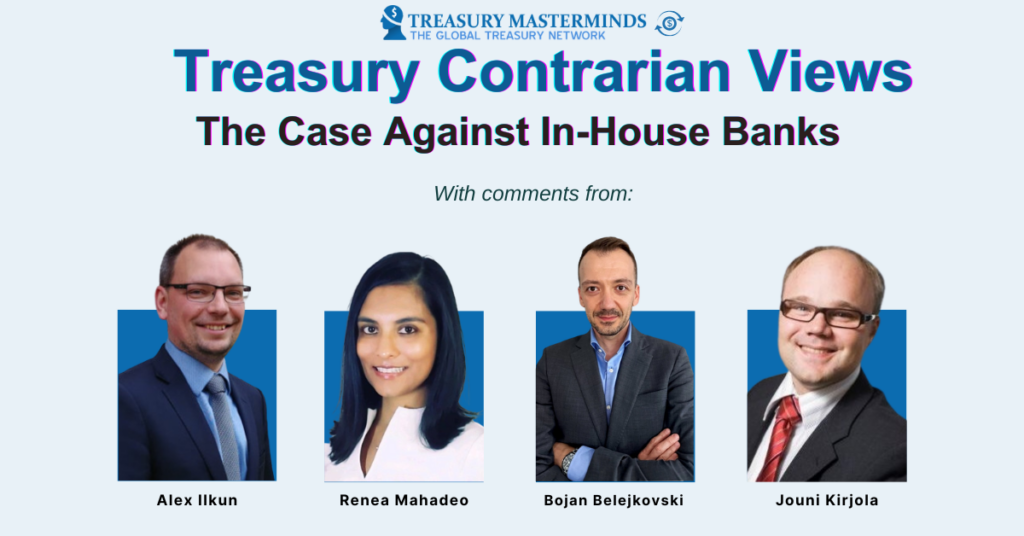
Treasury Contrarian View: The Case Against In-House Banks
For years, in-house banks (IHBs) have been promoted as the gold standard for multinational corporations seeking centralized control over cash, payments, and liquidity. But in a world of real-time payments, virtual accounts, and advanced fintech solutions, do we still need in-house banks, or are they becoming an outdated legacy structure? The Traditional Arguments for In-House Banks The Case Against In-House Banks The Alternative: A More Agile Treasury Model Instead of relying on a full-fledged in-house bank, treasury teams can consider: Let’s Discuss We’ll be sharing insights from treasury leaders and industry experts—join the conversation and share your perspective! COMMENTS Alex lkun, Treasury Masterminds board member, comments: In-House Bank isn’t dead, but it’s face is certainly changing. The traditional in-house bank is a cash concentration vehicle that the banks love so much for one big reason: it ties a multinational to them, making the operational business stickier and juicier. Not only you as a Treasurer end up relying on the bank to manage your cash pool (paying them for the privilege in the process), but you also are incentivized to move more accounts and cash for the bank, as it is difficult and expensive to pool across banks unless you look for some alternative structures. Thankfully, there is a solution that allows multinationals to take back some control of their cash with the use of the tools available today. With a combination of TMS and bank connectivity tools, it is possible to set up a multi-bank cash pooling structure that reduces reliance on any single bank, moving the balance of negotiating power to the multinational but also allowing them to deepen relationships with the key banking partners in areas where they can provide significant value. In such a structure, TMS monitors the cash balances and cash needs, managing balances on each account that is part of the pool, moving the funds where they are necessary to make payments. With such a structure, one can imagine a cash-never-sleeps model, where the working capital is traversing the world during the working hours in each of the time zones to ensure its availability and full utilization on one hand, but also maximising the investment opportunity of excess funds. Granted, one looking for a solution that will be suitable for every currency and jurisdiction under the sun will find such a goal unattainable. However, this approach could work for major currencies and is based on a well-known, proven foundation that legal, tax, accounting, and compliance teams will find more palatable than some of the other solutions. Renea Mahadeo, Treasury Masterminds board member, comments: Recent advancements in APIs, virtual accounts, blockchain, and AI agents have expanded the treasury toolkit, transforming how organizations optimize cash, liquidity, funding, and risk management. Traditional solutions were rigid, costly, and slow to adapt, leaving companies at a competitive disadvantage in a rapidly evolving digital world. The question is no longer whether treasury should invest in technology, but rather which technologies will future-proof operations. To build the next generation of in-house cash orchestration, start with APIs and virtual accounts – these offer a low-cost, high-impact foundation before exploring blockchain and AI. Virtual accounts, powered by APIs, replicate the benefits of in-house banks without the regulatory and operational burdens, enabling real-time cash concentration, intercompany funding, and payment centralization with greater speed and flexibility. Regulatory and compliance considerations should not be overlooked. While virtual accounts are widely accepted and used by financial institutions worldwide, some jurisdictions have specific regulatory constraints regarding their use. It is best to work closely with banking partners to understand the legal framework requirements. Beyond this, blockchain and AI agents represent the next frontier. Treasurers should shift from asking, How long will a system customization take? to how can programmable payments and smart contracts optimize liquidity? When treasury processes mature, AI agents can autonomously manage liquidity across global subsidiaries, running 24/7 with real-time decision-making. If we now have access to always-on technology, why not fully leverage it to build a more agile, automated, and cost-efficient treasury ecosystem? Bojan Belejkovski, Treasury Masterminds board member, comments: While in-house banks (IHBs) offer centralization benefits, they can be costly and impractical. The investment in technology, compliance, and personnel may outweigh the benefits, especially for organizations with diverse operational needs. Forcing business units or subsidiaries into a rigid IHB structure can create inefficiencies, as each unit may have unique relationships, regulations, and funding strategies. Even with a shared bank, ERP, and TMS, an IHB can be an unnecessary burden. Modern treasury technology, virtual accounts, and real-time payments already offer centralized cash visibility without the complexity. Also, the regulatory, tax, and compliance challenges, along with managing intercompany loans and transfer pricing, add administrative overhead that fintech solutions can address with greater flexibility and lower costs. Jouni Kirjola, Head of Solutions & Presales, Nomentia, comments: While virtual accounts can reduce certain complexities compared to IHBs, they also introduce new challenges. Companies relying on virtual accounts remain heavily tied to their banking partners, increasing counterparty risk and reducing overall control. This dependency can become problematic, particularly in volatile markets or regions with limited banking options. It’s true that IHBs come with regulatory and compliance requirements, but not across all regions. In reality, regulatory complexities vary significantly depending on jurisdiction. In some cases, an IHB can actually simplify compliance by consolidating reporting and controls rather than increasing complexity. The claim that IHBs require significant investment in infrastructure, compliance, and personnel—sometimes outweighing operational benefits—is valid. However, the same applies to virtual accounts, which can also require substantial implementation effort, ongoing management, and regulatory compliance. The cost-benefit equation isn’t inherently tilted against IHBs. Modern TMS, APIs, and AI-driven analytics offer impressive real-time visibility, but they don’t fully address critical aspects of intercompany funding and balance management. Bookkeeping too must remain efficient, structured, and compliant—something IHBs are designed to handle effectively. When discussing real-time payments and APIs for moving cash instantly, it’s important to recognize that IC balances must be carefully managed. An IHB can eliminate the need for frequent balance transfers, providing…
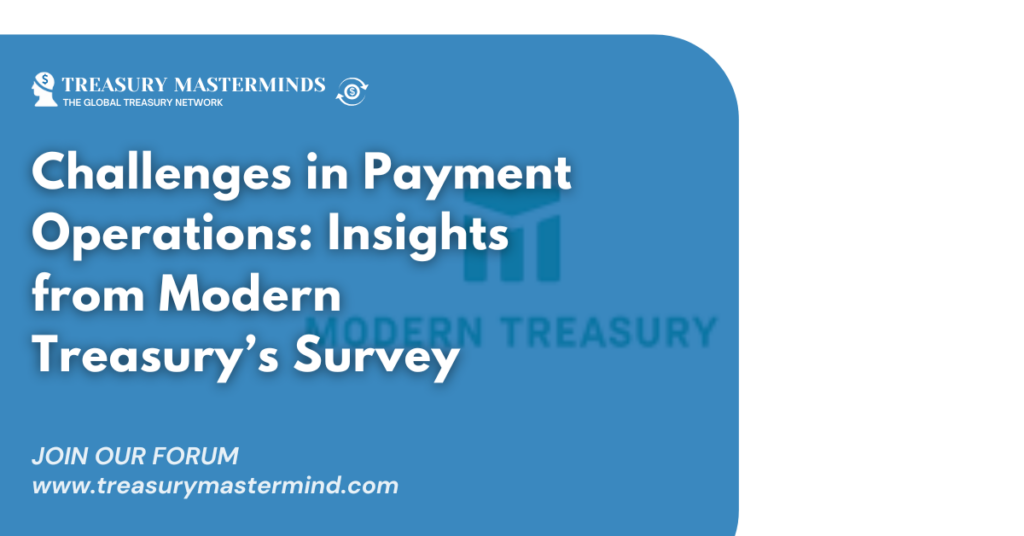
Challenges in Payment Operations: Insights from Modern Treasury’s Survey
As businesses strive to adapt to the fast-moving demands of the “Instant Economy,” they are facing increasing difficulties in streamlining their payment operations. According to Modern Treasury’s fourth annual State of Payment Operations 2025 report, which surveyed 500 financial decision-makers, nearly 90% of companies are grappling with inefficient and manual payment processes. The survey highlights the most significant issues: 47% of businesses report their payment operations as manual, while 35% describe them as complicated. Slow and inefficient processes, affecting everything from payment returns to reconciliation errors, further exacerbate these challenges. These hurdles not only increase operational costs and risks but also waste employee time and can lead to costly audit mistakes. Key findings from the survey include: In response to these challenges, companies are increasingly turning to automation and AI to modernize their payment operations. The survey reveals that 64% of companies already use AI to automate payments, with 95% planning to do so in the future. Furthermore, 56% of companies use instant payment rails, with another 37% planning to adopt them in the next year. Dimitri Dadiomov, CEO and co-founder of Modern Treasury, noted that legacy infrastructure limits companies’ ability to capitalize on innovations such as real-time payments and AI. However, modern payment technologies are offering a path forward, enabling businesses to streamline operations and reduce errors. Rachel Pike, Chief Operating Officer at Modern Treasury, emphasized that real-time payment operations are essential for companies to meet the evolving expectations of instant access to goods and services. As transaction volumes rise, investing in modern payment infrastructure is not just an option but a necessity. In conclusion, businesses must embrace automation, AI, and real-time payment systems to stay competitive in an increasingly fast-paced world. For more insights on how businesses can navigate these changes, read the full survey results here. Also Read Join our Treasury Community Treasury Mastermind is a community of professionals working in treasury management or those interested in learning more about various topics related to treasury management, including cash management, foreign exchange management, and payments. To register and connect with Treasury professionals, click [HERE] or fill out the form below to get more information. Notice: JavaScript is required for this content.

Treasurers or Traders?
This article is a contribution from our content partner, TreasurySpring For nearly a decade post the global financial crisis, the rates market was a fairly predictable, benign, unexciting place to be. Data and headlines barely shifted the needle, and traders, investors, and treasurers could quite accurately forecast and achieve expected borrowing rates and returns across most core currencies. Now however, quite the opposite is true, with widespread disagreement among strategists, traders and even Central Bankers as to what the ideal future path of interest rates should look like, let alone what it will actually look like. So how should treasurers, those custodians of a company’s capital and planners of a business’s budget think about a world of much more volatile interest rates? Terming out your cash to achieve a smoothed, blended return, while keeping enough cash available for business as usual and, of course, adhering to your treasury policy, should be the target for treasurers. It’s standard practice for borrowing, and the same factors apply. We only have to look back over 2024 to see how. For traders, volatility is good. As a rates speculator, daily movements in interest rate expectations, jumping from one piece of data or news to the next, allows you to make money if you get on the right side of the trade. Of course, get on the wrong side and you lose money. Ultimately, the difference between a good trader (or, a cynic might say, a lucky trader) and a bad trader is being on the right side more often than the wrong side. We saw lots of volatility in 2024. We don’t have to look much further than Central Banks to find more of it than most treasurers should want. At the end of 2023, the range of the Fed members’ expectations for the Fed Funds Rate was 3.9%-5.4% – that’s six ‘regular’ rate cuts’ difference between the highest and lowest! Markets were pricing in 150bps of cuts over the year, with a first cut in March. We had to wait until September as it turned out. Looking ahead to December 2025, and, as of September 2024, the voting members once again varied their views with a 1.5% range. For 2025, the market expectation was for further cuts to come, but how many and how soon was once again producing a wide range of views, with some even considering the possibility of a rate rise before the end of the year. Not surprising, given the possible volatility on the cards in 2025. None are so obvious as the uncertainty surrounding the return of Donald Trump as US President. How many of his policies will he be able to enact and how soon into his tenure? Will they all be as harsh as he has said they will be? And how will other countries react to any sanctions such policies will place on them? The ECB and the Bank of England are also on a dovish path, but, again, predicting how many and when is far from an exact science. Historically, when rates come down, they come down quicker than they went up, and they stay at peaks for shorter periods of time than they stay at lows. So as a treasurer, trying to pick those tops is a dangerous game and, quite often, if you don’t move quickly, it’s gone. Looking at these risks, as a treasurer looking at borrowing, while you can try and find a ‘good day’ to do your deal and try to achieve a marginally lower rate than the previous week, or perhaps month if you have that luxury, your first aim is to get a successful transaction, your second aim is to smooth your maturity profile to reduce any future refinancing risk, and then you aim to achieve the lowest blended cost of funding you can. The latter two come with regularly spaced deals, and, if executed correctly, allow you to deliver pretty accurate forecasts to your board of future interest costs, locking in rates, and reducing risks due to market volatility. On the other side, placing your carefully raised cash, as a treasurer, you presumably equally want to remove that risk of market volatility affecting your interest rates, locking in rates, and reducing market volatility risk – again allowing you to deliver pretty accurate forecasts to your board of future interest income. (Assuming you’ve got a good finance team to give you accurate cash flow forecasting of course). Yet many treasurers stick to rolling their cash overnight, taking whatever rate the market is paying that day, moving up or down at the whims of traders with very different aims for their financial years. Traders spend hours poring over charts, analysing the output of models, and considering the effects of varying factors on rates before making their trades. While many treasurers I know are always keen to learn and consider different approaches and opinions, one thing I know they don’t have is much time; especially not the sort of time traders spend considering their trades before placing them. So it feels like an unfair advantage if treasurers are trying to take on traders at their own game. Traders don’t always get it right, but they do it enough times that, hopefully, the profits outweigh the losses. The Federal Reserve and other central bankers, as highlighted above, also get it wrong, with almost infinite access to information. Ultimately, it’s a brave treasurer who believes they can call it right more often. So why not approach your cash asset management in the same way you do your liability management? Accept predicting rates is near enough impossible and term out your cash where possible with a range of maturities, producing a smoothed curve of maturities and a much less volatile level of interest income. Potentially also diversifying the institutions your cash is placed with too. Also Read Join our Treasury Community Treasury Masterminds is a community of professionals working in Treasury Management or those interested in learning more about various topics related…
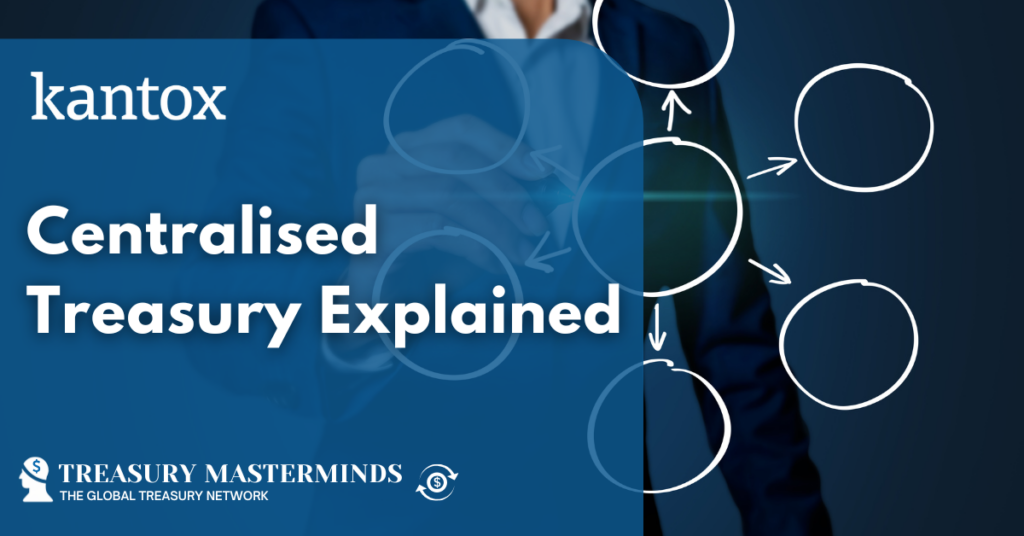
Centralised Treasury Explained
This article is written by Kantox In turbulent times, it is more difficult to achieve higher risk mitigation, control, and visibility over cash. This has been a driver for centralisation in recent years and, as CFOs and treasurers seek to gain an accurate view of the cash held by their organisations, we have seen the topic of centralised treasury picking up interest. In this blog post, we’ll dive into what centralised treasury entails, explore its benefits, shed light on the importance of centralised foreign exchange (FX), and discuss why businesses need centralised FX along with its implementation. Understanding the main goal of Treasury The primary objective of treasury management is to plan, organise, and control cash to meet the future financial goals of the organisation. Treasurers manage risk by applying risk transfer and hedging techniques that comply with the company’s internal policies – in many cases supported by a treasury management system (TMS) and other tools, such as spreadsheets and other treasury technology. The popularity of in-house banks has been on the rise during the last decade. Pioneering treasurers have been using an in-house bank for years to centralise payments, collections, and loans as well as optimise liquidity and risk management. As the in-house bank is a proven concept that can be adopted at the own pace of an organisation, group treasurers are starting to show increasing interest in in-house bank software solutions. What is Centralised Treasury? Centralised treasury is a financial management approach where a company consolidates its treasury functions into a single, strategic hub. This central hub manages various financial aspects, including cash management, risk management, and liquidity, bringing together disparate treasury activities under one umbrella. A centralised Treasury model offers the advantage of consolidated control, standardised processes, and enhanced efficiency across borders. Benefits of Treasury Centralisation 1. Ease of Use Centralising treasury functions simplifies daily operations. Companies reduce redundancies and streamline their financial workflows by consolidating tasks like cash management and payment processing. This simplicity translates to improved efficiency and reduced operational costs. 2. Centralised Control With treasury activities housed in a centralised system, businesses gain better control over their financial operations. This centralised control ensures adherence to policies and enhances risk management by enforcing standardized processes across the organization. 3. Better Forecasting Accurate forecasting is crucial for effective financial planning. Centralised treasury provides a consolidated view of financial data, facilitating more accurate predictions of cash flows, liquidity needs, and potential risks. This foresight empowers businesses to make informed decisions and adapt proactively to market changes. 4. Full Visibility of Exposure Centralised treasury offers a comprehensive view of a company’s financial exposure. This visibility allows businesses to identify and mitigate risks associated with currency fluctuations, interest rates, and other market variables. A clear understanding of exposure positions a company to make strategic decisions that protect its financial health. Why Do You Need Centralised FX? When organisations are looking for a way to improve cash flow processes, cash visibility, and reduce bank fees, the in-house bank can be a great alternative compared to their subsidiaries working with countless banks internationally. Let’s understand why: 1. Mitigating Risks Centralising foreign exchange (FX) activities is paramount for risk mitigation. Fluctuations in currency values can significantly impact a company’s financial health. By centralising FX operations, businesses can implement hedging strategies more effectively, shielding themselves from currency risk. 2. Efficiency in Execution A centralised FX approach streamlines the execution of currency transactions. Through a unified platform, companies can achieve better rates, reduce transaction costs, and improve overall efficiency in managing international payments and receipts. 3. Enhanced Decision-Making Centralised FX provides decision-makers with real-time insights into currency positions and market trends. This enables proactive decision-making, allowing businesses to shield themselves from unexpected adverse economic events and minimise the impact of unfavourable forward points. Implementing Centralised FX With the understanding of why centralised FX is essential, the next step is implementing it seamlessly into your financial strategy. Here are key considerations: In Conclusion Large multinational companies that move towards centralisation of decision-making will reduce the risk in the system because it pools resources and allows for the coordination of actions. When it comes to foreign exchange, centralisation can become a strategic move to optimise visibility, efficiency, and control. Also Read Join our Treasury Community Treasury Masterminds is a community of professionals working in Treasury Management or those interested in learning more about various topics related to Treasury Management, including Cash Management, Foreign Exchange Management, and Payments. To register and connect with Treasury professionals, click [HERE] or fill out the form below to get more information. Notice: JavaScript is required for this content.
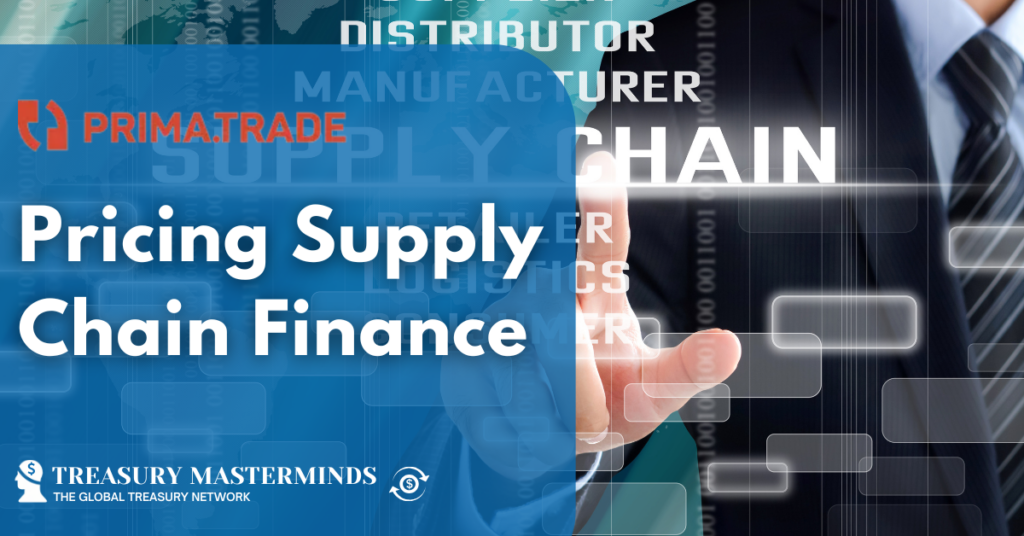
Pricing Supply Chain Finance
This article is a contribution from our content partner, PrimeTrade There is quite some debate on best practice when it comes to pricing the discount that suppliers might be offered for early payments on their invoices. We have developed a framework that companies can use to decide how to approach the pricing of early payment options that suppliers are offered. The debate about pricing supplier finance spans all the flavours of program including reverse factoring, supply chain finance (“SCF”) and dynamic discounting. This blog is a bit longer than usual (6 minutes) – but this is a topic that is worth exploring in some detail. For background on supply chain finance, see this article from the UK Association of Corporate Treasurers. At PrimaTrade we provide a platform that gives buyers the maximum flexibility to manage their supply chains however they want. The ethical debate: “supply chain fairness” There are several levers available to companies when they consider how to manage their days payable outstanding (“DPO”). There are some choices to make: Picking an optimal invoice term is for another blog post, itself an interesting topic given existing and incoming constraints on terms, such as prompt payment codes and even binding rules (eg: EU Working Capital Directive). For the purpose of this blog, we are focussing on the pricing question: “what discount should suppliers be offered if they access supplier finance?” Supplier discounts for early payment Most forms of supplier finance involve the supplier accepting a discount on the invoice that they are owed in exchange for an early or instant payment. For example, an invoice of 100 might be due from the buyer in 90 days, and the supplier might have the option to receive 97 now rather than wait. | There can be strong views on right and wrong here. Pricing supply chain finance – framework Our experience talking to CFOs and Corporate Treasurers is that there can be quite strong opinions on the best model and where ethical lines need to be drawn. And, just to emphasise again, PrimaTrade’s platform supports all approaches and we are not here to judge. Our framework is summarised here and described in more detail below. The four pricing models for supply chain finance 1. “Dynamic discounting“: Suppliers are asked to bid for early payments which the buyer organises based on an auction. In this model, the price and availability of early payments depends on suppliers bidding against each other. This approach can maximise the dollar return to the buyer on cash that is paid to suppliers early – typically employed when the buyer uses its own funds and there is a limited amount of funds available. 2. “Lowest possible cost“: Suppliers are offered the cheapest possible cost for early payments, which enables suppliers to access early payments at will and very efficiently – improving their liquidity and financial position. Moreover, some companies can sometimes take an absolute position that they should not “make money out of suppliers” and this option clearly makes sure that is not happening. 3. “Market pricing“: Pricing for early payments is set slightly at or above the expected “typical” cost that a supplier might incur if the supplier were to fund itself in the market and not use the program. For example, if suppliers could fund the period until the invoice due date with their own resources at a cost of 1% per month, then perhaps set the cost of early payment at 1% to 1.25% per month. 4. “Split the difference“: Pricing is set halfway between the expected cost that suppliers might incur externally not using the program, and the buyer’s actual funding cost. Here the arbitrage between the lower cost of finance the buyer might enjoy and the supplier’s typical higher cost of finance is shared between the two parties. Pricing supplier finance – discussion In the example cases below, suppliers are assumed to be providing goods and services and issuing invoices with a credit term. There is a supplier financing program available enabling suppliers to get paid more quickly with a discount. Moreover, supplier financing is assumed to be a choice for suppliers. Ideally, suppliers should have the ability to opt in and out of supplier financing each time they supply the buyer. | What discount should apply to supplier finance? 1. Supplier resilience is not in question: 2. Supplier financing can be relied upon long term: 3. Supplier resilience should be maximised: 4. Supplier financing should, above all else, be ethical: Is there a “goldilocks” option? Most companies organise supplier financing programs in order to maximise the resilience of their supply chain. They can also be very conscious that it might not be healthy if suppliers become dependent on a supplier financing program, which might not always be available. This might lead to a choice between option 3 and option 4 above – “market pricing” and “split the difference“. Also Read Join our Treasury Community Treasury Masterminds is a community of professionals working in treasury management or those interested in learning more about various topics related to treasury management, including cash management, foreign exchange management, and payments. To register and connect with Treasury professionals, click [HERE] or fill out the form below. Notice: JavaScript is required for this content.

Treasury Contrarian View: ESG in Treasury—A Passing Trend or the Future?
Environmental, Social, and Governance (ESG) considerations have been a growing focus in corporate finance, but is ESG in treasury truly transformative, or just another temporary compliance-driven trend? Many organizations are embedding ESG into their financial strategies, while others remain skeptical about its long-term value. So, is ESG in treasury here to stay, or is it just a passing trend? The Case for ESG as the Future of Treasury ESG factors directly impact financial risk management. Climate change risks, social governance challenges, and regulatory shifts can affect supply chains, investment decisions, and operational costs. The Case Against ESG as a Lasting Priority in Treasury A Pragmatic Approach: ESG as an Evolving Opportunity Rather than viewing ESG as either a short-term trend or a mandatory requirement, treasury teams can take a strategic approach: Let’s Discuss We’ll be sharing insights from our board members and treasury partners on how they view ESG in treasury—join the conversation and let us know your perspective! COMMENTS Jessica A. Oku, Treasury Masterminds board member, comments: It’s neither a passing trend nor a silver bullet, really. I’ve seen companies jump on the ESG financing trend, securing lower interest rates on sustainability-linked loans, only to realize later that the ESG targets tied to those loans were either too vague or too difficult to measure. If there’s no clear way to track progress, ESG financing can quickly become more of a branding tool than a strategic financial move. The real question is: Are these funds truly being used to drive sustainable business practices, or are they just an easy way to access capital? If treasury teams don’t have strong ESG performance indicators in place, they could end up in a tough spot, either failing to meet investor expectations or facing penalties for not hitting sustainability goals/loan covenants. I’ve seen it happen too often, companies rolling out ESG policies just to tick a box for investors and regulators, without actually making meaningful changes. They publish polished sustainability reports, but when you look at their treasury or company-wide operations, it’s business as usual. Short-term financial goals still take priority, and ESG is more of a PR move than a real strategy. The real question is: Are ESG initiatives actually influencing treasury decisions, or are they just another reporting requirement? If ESG isn’t shaping how cash flow is managed, how investments are made, or how financial risks are assessed, then it’s not truly integrated. Another issue is the disconnect between treasury teams and sustainability departments. Treasury might be focused on financial performance, while sustainability teams are pushing ESG goals, but if they’re not working together, ESG remains a separate, surface-level initiative. For ESG to actually mean something in treasury, it needs to be baked into everyday decision-making, like factoring sustainability risks into funding strategies or using green financing to create real financial advantages. At the end of the day, ESG shouldn’t be treated as extra work or just another compliance or marketing “checkbox.” Lack of standardization and metrics is a big roadblock. I’ve spoken with treasury teams who struggle with multiple ESG frameworks, making meaningful financial comparisons difficult. Without clear, standardized ESG metrics, how can we expect treasury functions to make informed decisions? Until the industry consolidates around universal ESG standards, this will remain a challenge. Csongor Máthé, Product Manager/ESG Lead at TreasurySpring, comments: Traditionally, treasury decision-making has focused on security, liquidity, and yield, but ESG is adding a new dimension to consideration. However, a recent downshift in ESG sentiment, driven by macroeconomic factors, increased scrutiny of greenwashing and the politicisation of the topic, may prompt a more cautious approach. While ESG in treasury may often be perceived as driven by regulation and external pressure, our most recently published ESG survey of treasurers (2024) painted a more nuanced picture. Only 5% of respondents identified investor or lender pressure as the primary driver of their ESG strategy, while 53% pointed to corporate social responsibility (CSR). In terms of regulatory changes like the Corporate Sustainability Reporting Directive, only 16% of treasurers have actively adapted their ESG cash investment strategies and practices in response. Treasury teams are integrating ESG principles into decision-making, but its impact varies across financial areas. Our ESG survey found ESG principles are most commonly applied to cash investing (47%) and long-term financing (44%), followed by supply chain management (35%) and short-term financing (28%). When it comes to financing, ESG is already well-established in some areas (and less so in others). The sustainable bond market, for example, benefits from a high level of standardisation, with the vast majority of issuances aligning to the ICMA Principles. This reduces the risk of greenwashing, seemingly making these instruments a more reliable and easier fit within long-term ESG treasury strategies. Eleanor Hill, Freelance Content Creator at Treasury Storyteller, comments: It’s easy to take pot shots at ESG, dismissing it as marketing fluff, regulatory box-ticking, or just another way for companies to look good. Of course, with CSRD and other ESG-related rules and regulations, some companies’ ESG efforts are compliance-driven. But does that make all ESG initiatives meaningless? I’d say not. Many corporations are genuinely trying to drive change. And we must remember that it is still early days for ESG, so there will be missteps. Regulations also still need to evolve. But that doesn’t mean it’s not worth doing. And we only learn through trying – not through criticising from the sidelines, without presenting solutions. While the focus on ESG may be rolling back in some parts of the world, it’s certainly not in Europe. And the global challenges we face – climate risk, resource scarcity, and social inequality – aren’t disappearing just because the narrative is shifting. In terms of the ‘cost’ of ESG, yes, all changes involve some expense. And doing ESG right sometimes means implementing specialist systems or employing experts. But ESG can also be a profit driver. According to Equity Quotient, “Companies that proactively embrace their pursuit of stakeholder diversity and other ESG principles tend to be more successful, outperforming peers on…